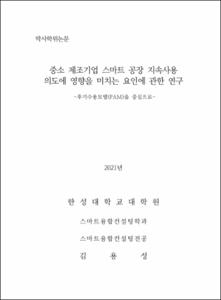중소 제조기업 스마트 공장 지속사용 의도에 영향을 미치는 요인에 관한 연구
= A study on the factors affecting the continuous use intention for smart factories of small and medium-sized manufacturing companies: Focus on the Post Acceptance Model (PAM)
- Type
- Thesis
- Alternative Title
- 후기수용모델(PAM)을 중심으로
- Department
- 대학원 스마트융합컨설팅학과
- Issued Date
- 2021
- Publisher
- 한성대학교 대학원
- Appears in Collections:
- 스마트융합컨설팅학과 > 1. Thesis
- Files in This Item:
-
-
Download
 200000362294.pdf
기타 데이터 / 2.99 MB / Adobe PDF
200000362294.pdf
기타 데이터 / 2.99 MB / Adobe PDF
-
Items in Repository are protected by copyright, with all rights reserved, unless otherwise indicated.